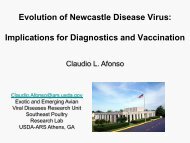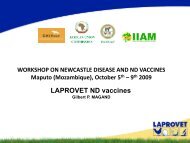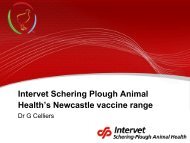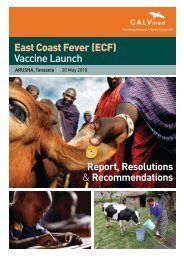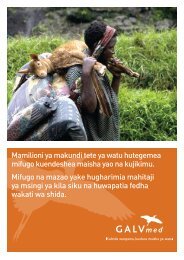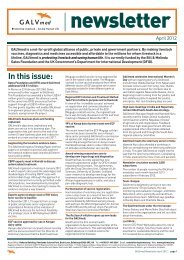A Path to Prosperity New Directions for African Livestock
GALVmed Impetus Strategy Paper
GALVmed Impetus Strategy Paper
- No tags were found...
You also want an ePaper? Increase the reach of your titles
YUMPU automatically turns print PDFs into web optimized ePapers that Google loves.
There was mixed opinion on whether small scale<br />
producers feed a balanced ration <strong>to</strong> their ruminant<br />
lives<strong>to</strong>ck. It was generally felt there was room from<br />
improvement. Examples of the positive impact of<br />
micro nutrient, vitamin and mineral supplements<br />
were given.<br />
One correspondent from FAO advocated greater use<br />
of annual assessments of available feed resources<br />
in SSA. Such assessments generate in<strong>for</strong>mation on<br />
what, how much and when different feed resources<br />
are available. This allows policy and management<br />
decisions <strong>to</strong> be taken regarding the use of these<br />
resources. In addition, such in<strong>for</strong>mation could<br />
enhance efficiency and profitability of animal feed<br />
industry and assist researchers <strong>to</strong> <strong>for</strong>mulate<br />
sustainable feeding strategies. Spatial and temporal<br />
assessments of current and <strong>for</strong>ecasted feed<br />
resources could significantly assist disaster<br />
preparedness and response, as feed could, where<br />
practicable, quickly be moved in<strong>to</strong> areas affected by<br />
emergencies such as droughts and floods. FAO<br />
has developed guidelines and a manual <strong>for</strong> the<br />
assessment of feed resources at national and<br />
regional levels and can assist countries in generating<br />
national feed inven<strong>to</strong>ries.<br />
The ISP had advocated development of dictionaries<br />
of the nutritive value of available feed resources in<br />
different parts of Africa. Feed dictionaries <strong>for</strong>m the<br />
basis <strong>for</strong> lives<strong>to</strong>ck ration <strong>for</strong>mulation and can be a<br />
means of minimizing feed costs. However it was<br />
noted that animal feed analysis labora<strong>to</strong>ries in SSA<br />
rarely have quality control systems in place.<br />
4 Small lives<strong>to</strong>ck farmers increasing<br />
their income – trade and market<br />
access<br />
The e-discussion initially focused on market access<br />
<strong>for</strong> small scale producers or smallholders. It was<br />
pointed out that access primarily depends on the<br />
market being targeted, the product being traded and<br />
the direction in which government policies move.<br />
It was noted that <strong>African</strong> cities with growing<br />
populations and growing incomes may provide an<br />
accessible market <strong>for</strong> smallholders <strong>for</strong> some time<br />
<strong>to</strong> come. The example of Nairobi was provided. Most<br />
lives<strong>to</strong>ck products sold in Nairobi have either walked<br />
or been carried across national borders through<br />
semi-regulated market chains with no <strong>for</strong>mal quality<br />
demands. It is the <strong>for</strong>mal marketing chains, like<br />
those in<strong>to</strong> supermarkets or <strong>for</strong> large-scale export,<br />
that start <strong>to</strong> introduce higher quality demands.<br />
“Here the effect may be <strong>to</strong> push out the smaller<br />
producer through more costly requirements<br />
<strong>for</strong> production and certification, or simply <strong>to</strong> make<br />
the market more unpredictable and less attractive <strong>to</strong><br />
smallholders who cannot bear the risk”.<br />
It was noted that small scale producers, as well as<br />
small scale traders and retailers, seem <strong>to</strong> survive<br />
longest in dairy market chains. Though there are<br />
exceptions <strong>to</strong> the rule. Smallholders and traditional<br />
production have been remarkably persistent in parts<br />
of Southeast Asia. In Brazil, there has been very little<br />
policy support <strong>to</strong> small scale dairy production and<br />
dairying has scaled-up and concentrated in the<br />
hands of large producers. However in India and East<br />
Africa, policy has largely favoured small holder dairy<br />
production, which now predominates. Poultry meat<br />
and egg production are very much associated with<br />
large-scale operations and big business. Backyard<br />
poultry remains a good livelihoods prop when reared<br />
on a very small scale <strong>for</strong> in<strong>for</strong>mal markets. In the<br />
middle ground, however, small scale commercial<br />
operations start up and close down very fast –<br />
they seem <strong>to</strong> be an important part of transition<br />
in the poultry sec<strong>to</strong>r but not a sustainable long<br />
term prospect. It was noted that ruminant meat<br />
production could go either way and policy<br />
development will be key <strong>to</strong> pushing production <strong>to</strong> or<br />
from small holders in Sub Saharan Africa. “Policies<br />
that support market infrastructure and training that<br />
small scale producers can access, fair contracts,<br />
quality regulation of services that small scale<br />
producers need, small retail businesses in peri-urban<br />
and urban areas, all make it possible <strong>for</strong> small scale<br />
producers <strong>to</strong> stay in business <strong>for</strong> longer”.<br />
Correspondents agreed that harmonisation of intra<br />
and inter regional lives<strong>to</strong>ck trade policies in Africa<br />
should encourage better structured and regulated<br />
markets and this could be very beneficial <strong>for</strong> small<br />
scale producers. It was advocated that intra<br />
regional trade initiatives need <strong>to</strong> provide better<br />
in<strong>for</strong>mation, support <strong>to</strong> producer groups and<br />
infrastructure development <strong>to</strong> enhance trade.<br />
The Impetus Strategy Paper I Page 81



